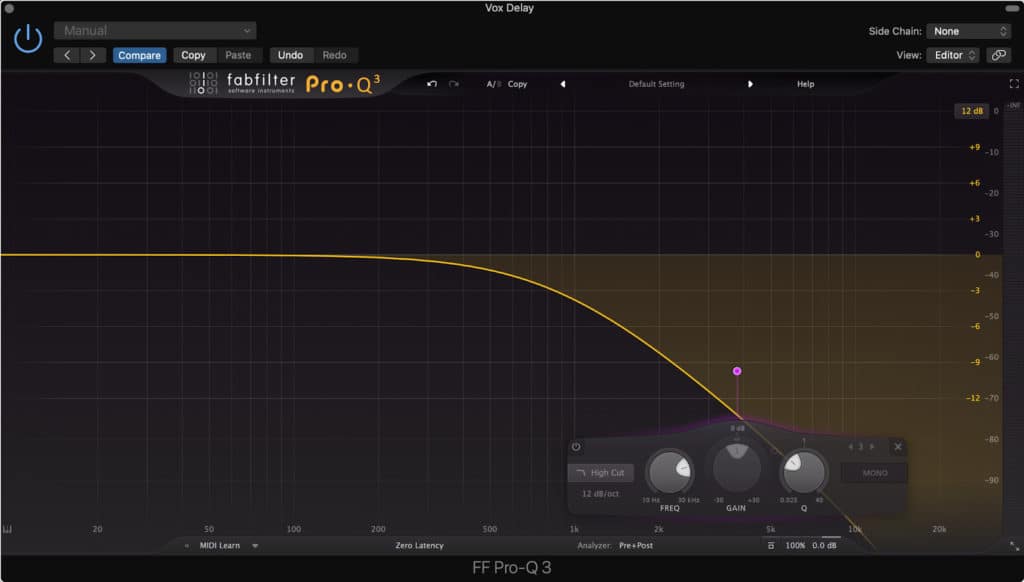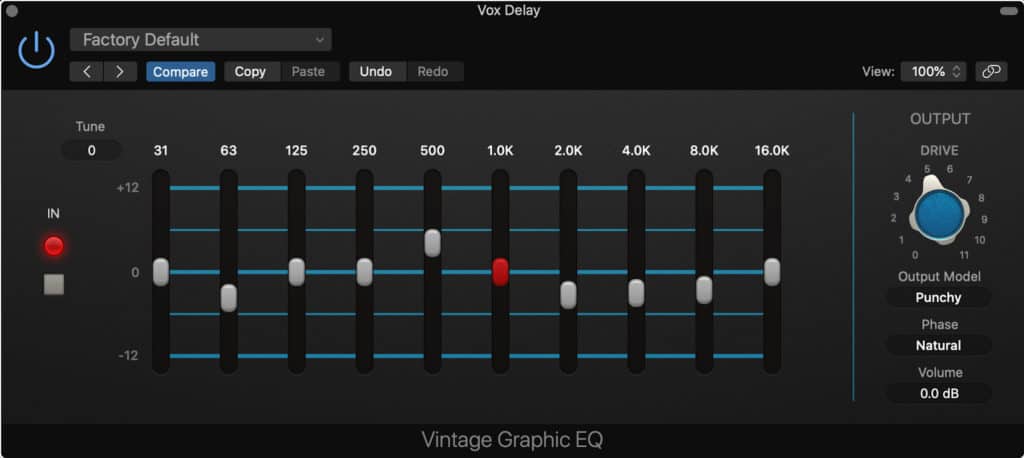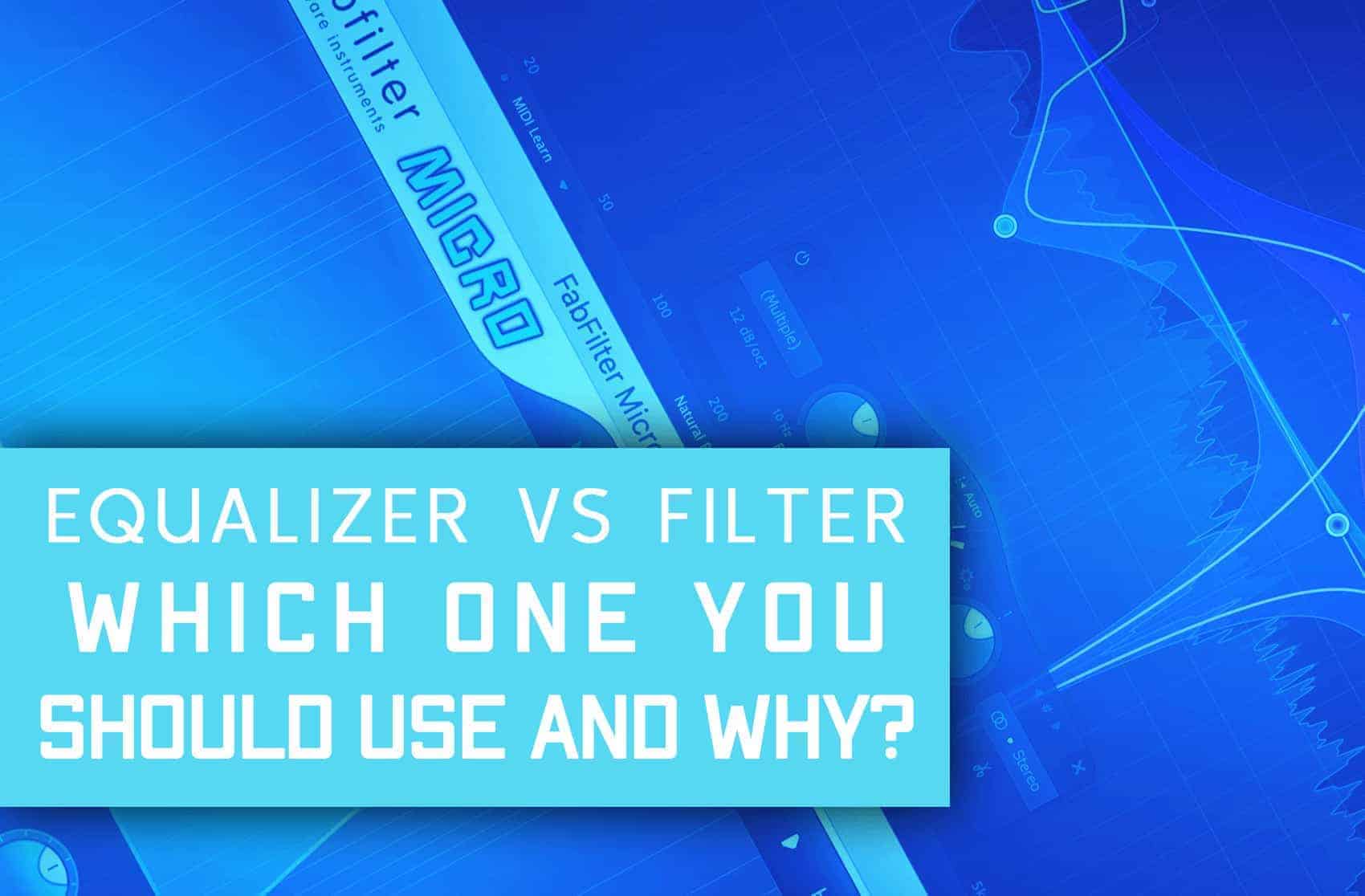Understanding the differences between EQs and filters is really important when choosing which to use in your music. There is a lot of overlap in their functions, but filters have their specific uses where they really shine.
Equalizers are used to both cut and boost/decrease frequencies and filters are used only to cut frequencies. However, filters are a lot simpler to use, and usually contain much more complex cutting options such as LFOs and other modulation options, and most equalizers don’t.
What Is An Equalizer?

Equalization, or EQ, is the process of adding or removing frequencies from a piece of audio. Every sound is made up of different frequencies, and they’re measured in Hertz, or HZ. The human ear can hear from 20Hz – 20,000Hz, although as we age, that decreases quite drastically in the upper end.
The frequency of a sound is the number of waves that pass a point in unit time – so if a wave is longer, it will take longer for it to pass a fixed point, so the frequency will be lower. The frequency determines the pitch of a sound.
EQ can be one of the most valuable tools in an engineer’s arsenal, and typically it’s used on multiple occasions within a session, often on almost every channel. It can be a great way of creating space and separation in a mix, and giving each element its own place.
If you think logically – there are only a certain amount of frequencies the human ear can hear, regardless of how densely a track is arranged, so carving space to give each instrument its own room can really help make a track sound full.
It’s also worth noting that in a lot of cases, the best mixes sound very well balanced in terms of frequencies, and there will be a spread of frequencies right across the audible spectrum.
When there’s a build-up of any individual frequency, it can sound really harsh to a listener, and it will also use up some of the valuable headroom and energy available to you in your mix.
People commonly expect to be able to transform a sound completely through use of EQ, and really drastically change the sound, and this isn’t necessarily the case. The source material can certainly be refined and enhanced, but rarely can it be completely transformed.
EQ can’t create frequencies that aren’t present in the source material to begin with.
What Is A Filter?
The process of filtering is very self-explanatory. Where an EQ can adjust many different parameters at once, filters tend to control just one. Filters essentially do what they say – they filter out, or remove certain frequencies.
There are four main types of filters: Low pass, High pass, bandpass, and band-reject.
High Pass Filters
A High Pass filter will cut off the low frequencies of an audio source, and allow the lows to pass through.

Low Pass Filters
A Low pass filter will cut off the high frequencies of an audio source, and allow the lows to pass through.

Band Pass Filters
A Band Pass filter is essentially a high and a low pass filter combined together, which will allow a fixed band of frequencies through.

Band Reject Filters
A Band reject, or notch, is the fourth type of filter, and that’s essentially just a single band EQ, which cuts out a certain band of frequencies.

These filters are commonly seen as options on plugins, but they’re also really common to see on synths or synth plugins.
Within subtractive synthesis, a filter is the second stage of the process, which removes frequencies from a harmonically rich waveform. The cutoff and resonance on a synth are parameters that control the shape and size of a filter.
Filter Shapes
As well as operating on different frequencies, filters can have different shapes. The main three different shapes for filters are cuts, shelves and notches.
A cut is where some frequencies are completely removed at either side of the spectrum, and this is usually a curve that starts at -inf dB, and curves up to -0dB at a particular frequency.
A shelf can be either a cut or a boost, and is a shape which again starts at either end of the frequency spectrum, but has a flat top, and then curves up or down to 0dB at a certain frequency.

Lastly, a notch is just a band or frequencies being either boosted or cut. They can appear anywhere on the frequency spectrum, and can be narrow or wide. They’re also sometimes called peaks or bells.
What Types Of Equalizers Are There?
Equalizers can take various forms, but most commonly nowadays, you’ll be familiar with them in parametric form, usually as a DAW plugin. Within a parametric EQ, there are 2 controls for changing the frequency.
Gain, Frequency, and Bandwidth, which is also known as Q. The Frequency moves the band from side to side, the gain moves it up and down, and the Q value changes the width of the peak or trough. Most DAWs feature a stock parametric EQ, such as Logic’s Channel EQ, or Ableton’s EQ Eight.
Parametric EQs can also come in the form of semi parametric EQs, and an example of this is EQ three in Ableton.
On a semi-parametric EQ, there are usually 3 or 4 bands, and controls for gain and sometimes frequency, but no Q control for bandwidth. These types of EQ are commonly seen on analog mixing consoles, both in studios and for live sound.
Quasi parametric EQs are another type of EQ, which offer similar controls to a parametric EQ, but with a choice of 2 or 3 preset shapes for Q value, such as a shelf, cut or fixed notch for example.
Graphic Equalizers work slightly differently, and they feature a set amount of fixed frequency bands, which can then have their individual gains boosted or cut.
For example, an 8 band graphic EQ might feature 80Hz, 120Hz, 200Hz, 400Hz, 600Hz, 1kHz, 2kHz, 5kHz, and 8 kHz. Each of these frequencies could then be boosted or cut but does not usually have any control of bandwidth. A famous example of a graphic EQ is the API 560.

Dynamic EQ is a final type of EQ which is a bit different. Dynamic EQ usually takes the form of a parametric EQ, but with some added functionality.
The bands on a dynamic EQ have thresholds that are level dependant, and the amount of gain applied through the EQ can change, depending on the level of incoming audio containing that frequency. They can be really useful for removing sibilance from vocals, or controlling hi-hat level in drum recordings, for example.
When should you use an Equalizer, and when should you use filters?
Choosing between using an EQ and a filter can be difficult, and often a combination of both can work best.
You may think from reading the above that you could just use a fully parametric EQ, such as Fab Filter Pro Q – 3 for all of your frequency-related needs, and to be honest, that’s a completely fair assumption. But depending on your workflow, and what you want to achieve, you might make different considerations.
Filters are typically defined by their slope, or the steepness of their filter cutoff. And they tend to have much steeper slopes than that of a regular parametric EQ.
Filters are usually much more appropriate choices for cutting out bass rumble or completely unwanted frequencies, whereas traditional EQs are much more appropriate for tone shaping.
Some engineers will approach the filtering process early in the mix, and begin by using plugins like ableton’s autofilter, or a single band EQ in Logic to cut out certain frequencies that they know they won’t want, and then they can apply a separate EQ to apply more creative frequency amendments.
Certain filters have a very particular sound to them, and especially in synthesis and sound design, engineers will choose certain filters that have a particular character to them, rather than using a parametric EQ. This is also applicable to DJs and electronic music producers, who often use filters to help create transitions and builds.
High Pass filters are very common in live sound, and are used to cut out the low frequencies on numerous channels in a mix, as to protect from low end rumble and feedback.







